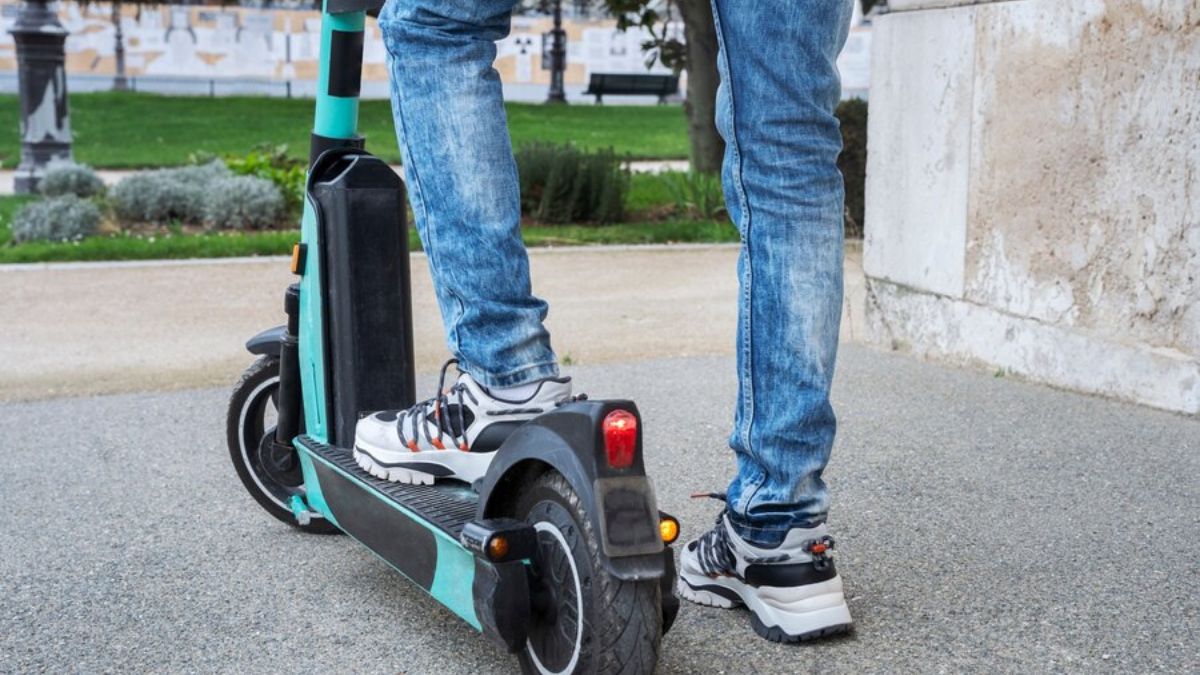TECHNOLOGY
Troubleshooting Common Issues with Segway Electric Scooters

Segway electric scooters have gained immense popularity as a convenient and eco-friendly mode of transportation. However, like any mechanical device, they can encounter various issues. This comprehensive guide will help you troubleshoot common problems and keep your Segway running smoothly.
Battery Issues
- Low Battery Life: If your battery isn’t holding a charge as long as it used to, it might be nearing the end of its lifespan. Factors like temperature, riding conditions, and charging habits can affect battery life. This is particularly common in older models like the Segway PT Mini, Segway i2, and Segway x2.
- Battery Charging Problems: If your Segway isn’t charging properly, check the charger for damage, ensure the charging port is clean, and try using a different outlet. If the problem persists, the battery itself might be faulty. This can occur in models such as the Segway Ninebot ES2, Segway Ninebot ES4, and Segway Ninebot Max G30.
- Battery Replacement: If you’ve ruled out other issues and your battery is still performing poorly, it may need to be replaced. Contact Segway’s customer support or an authorized service center for guidance. Battery replacement is more common in older models like the Segway PT Mini and Segway i2, as well as newer models like the Segway Ninebot Max G30 and Segway Ninebot F40.
Motor Issues
- Motor Failure: Motors can fail due to various reasons, including overheating, excessive use, or manufacturing defects. If your scooter isn’t accelerating or making unusual noises, the motor might be faulty. This can happen in any Segway model, but it’s more common in models with powerful motors, such as the Segway Ninebot Max G30 and Segway Ninebot F40.
- Motor Overheating: Overheating can damage the motor, especially during prolonged use or in hot weather. Avoid riding in extreme temperatures or for extended periods. This is a concern for all Segway models, but especially those with high-performance motors.
- Motor Replacement: If your motor is damaged beyond repair, it will need to be replaced. Contact a qualified technician or an authorized service center for assistance. Motor replacement is a major repair and can be expensive, especially for newer models with advanced motor technology.
Electrical Issues
- Controller Malfunctions: The controller is the “brain” of your Segway. If it’s malfunctioning, it can cause various issues, including erratic behavior, power loss, or failure to start. Controller problems can occur in any Segway model, but they are more common in older models or those that have experienced water damage.
- Wiring Problems: Loose or damaged wires can lead to electrical problems. Inspect the wiring for any signs of wear or damage. Wiring issues can occur in any Segway model, but they are more common in older models or those that have been involved in accidents.
- Sensor Failures: Sensors play a crucial role in the scooter’s operation. If a sensor fails, it can cause issues like incorrect speed readings or instability. Sensor failures can occur in any Segway model, but they are more common in models with advanced features like self-balancing or obstacle avoidance.
Mechanical Issues
- Tire Wear and Punctures: Regular tire wear is expected, but excessive wear or punctures can affect the scooter’s performance and safety. Inspect your tires regularly and replace them when necessary. Tire wear and punctures can occur in any Segway model, but they are more common in models that are used frequently or ridden on rough terrain.
- Suspension Problems: If your scooter feels rough or bouncy, the suspension system might be damaged or worn. Inspect the suspension components for any signs of damage or wear. Suspension problems can occur in any Segway model, but they are more common in models with larger wheels or those that are used on rough terrain.
- Brake Malfunctions: Faulty brakes can compromise your safety. Inspect the brakes regularly and replace worn-out components. Brake malfunctions can occur in any Segway model, but they are more common in older models or those that have been involved in accidents.
Connectivity Issues
- Bluetooth Pairing Problems: If you’re having trouble pairing your Segway with your phone, ensure both devices are in pairing mode and within range. Try restarting both devices. Bluetooth pairing issues can occur in any Segway model that has Bluetooth connectivity, such as the Segway Ninebot Max G30, Segway Ninebot F40, and Segway Ninebot KickScooter E22.
- Mobile App Connectivity Errors: App glitches or outdated versions can cause connectivity issues. Update the app to the latest version and try restarting both the app and the scooter. App connectivity errors can occur in any Segway model that uses a companion app, such as the Segway Ninebot Max G30, Segway Ninebot F40, and Segway Ninebot KickScooter E22.
- Firmware Updates: Keeping your Segway’s firmware up-to-date can help address connectivity issues and improve overall performance. Check for firmware updates through the Segway app or on the Segway website. Firmware updates are available for most Segway models, but the specific process may vary depending on the model.
Diagnostic Tools
- Segway Diagnostic Software: Some Segway models have built-in diagnostic software that can help identify and troubleshoot issues. Consult your user manual for instructions on how to access and use this software. Diagnostic software is available in some Segway models, such as the Segway Ninebot Max G30 and Segway Ninebot F40.
- Multimeter Testing: A multimeter can be used to test the electrical components of your Segway, such as the battery, motor, and controller. However, using a multimeter requires technical knowledge and should only be attempted by experienced individuals. Multimeter testing can be used to diagnose electrical problems in any Segway model, but it requires technical expertise.
- Error Code Interpretation: If your Segway displays error codes, consult the user manual or contact Segway’s customer support for assistance in interpreting and resolving the issues. Error codes can be displayed on the dashboard or through the companion app in some Segway models.
Maintenance and Preventative Care
- Regular Inspections: Conduct regular inspections of your Segway to identify and address potential issues before they escalate. Check the tires, brakes, lights, and other components. Regular inspections are essential for maintaining the safety and performance of your Segway, regardless of the model.
- Lubrication and Cleaning: Regularly lubricate moving parts, such as the steering mechanism and brakes, to ensure smooth operation. Clean the scooter regularly to remove dirt and debris. Lubrication and cleaning are important for all Segway models, but the specific requirements may vary depending on the model and usage.
- Storage and Transportation: When storing your Segway, ensure it is in a dry, sheltered location. Avoid storing it in extreme temperatures or humidity. When transporting your Segway, secure it properly to prevent damage during transit. Proper storage and transportation are essential for preserving the lifespan and performance of your Segway, regardless of the model.
Repair and Replacement
- Authorized Service Centers: For major repairs or replacements, it’s recommended to seek assistance from an authorized Segway service center. They have the expertise and tools to diagnose and repair your scooter effectively. Authorized service centers can provide professional repairs and replacements for all Segway models.
- DIY Repair Guides: If you’re comfortable working on your Segway yourself, you can find DIY repair guides online or in the user manual. However, be cautious when attempting repairs, as incorrect procedures can lead to further damage. DIY repairs can be a cost-effective option for minor issues, but they require technical knowledge and skill.
- Sourcing Replacement Parts: When replacing parts, ensure you obtain genuine Segway parts to maintain the scooter’s quality and performance. You can purchase replacement parts from authorized Segway dealers or online retailers. Genuine Segway parts are essential for maintaining the safety and performance of your scooter, regardless of the model.
Common Segway Models
- Segway PT Mini: One of the earliest Segway models, known for its small size and maneuverability.
- Segway i2: Another early model with a slightly larger frame and improved features.
- Segway x2: A larger and more powerful model with off-road capabilities.
- Segway Ninebot ES2: A popular budget-friendly model with a range of up to 25 miles (ca. 40 km).
- Segway Ninebot ES4: A more powerful version of the ES2 with a range of up to 37 miles (ca. 60 km).
- Segway Ninebot Max G30: A high-performance model with a range of up to 62 miles (ca. 100 km) and off-road capabilities.
- Segway Ninebot F40: A powerful model with a range of up to 68 miles (ca. 109 km) and a top speed of 40 mph (ca. 64 km/h).
- Segway Ninebot KickScooter E22: A lightweight and portable model with a range of up to 22 miles (ca. 35 km).
Conclusion
You can make sure that your Segway electric scooter provides dependable and entertaining transportation for many years to come by adhering to these troubleshooting guidelines and performing regular maintenance.
TECHNOLOGY
The Impact of Alaya AI on Business Efficiency and Productivity

Introduction to Alaya AI
In today’s fast-paced business landscape, staying ahead of the competition is crucial. Enter Alaya AI, a transformative technology that’s changing the way companies operate. Imagine having an intelligent system that streamlines processes, increases productivity, and enhances decision-making—all at once.
This innovative artificial intelligence solution is designed to understand your unique business needs and adapt accordingly. As organizations harness the power of Alaya AI, they find new opportunities for growth and efficiency like never before.
Join us as we explore how Alaya AI is revolutionizing business operations across various industries. From real-world case studies to insights on its advantages and potential challenges, discover why this cutting-edge tool might just be the key to unlocking your company’s full potential in today’s digital age.
How Alaya AI is revolutionizing business operations
Alaya AI is transforming the way businesses operate by streamlining processes and enhancing decision-making. By leveraging advanced algorithms, it analyzes vast amounts of data in real-time. This allows companies to make informed choices quickly.
Automation plays a crucial role here. Routine tasks that once consumed hours can now be completed in minutes. Employees are freed from mundane duties, allowing them to focus on strategic initiatives.
Moreover, Alaya AI offers predictive analytics that identifies trends before they become apparent. Businesses can anticipate market shifts and adapt accordingly.
Collaboration becomes more efficient as well. Teams access shared insights easily, fostering innovation and creativity among members.
With its user-friendly interface, businesses of all sizes can integrate Alaya AI seamlessly into their operations without extensive training or resources needed for implementation. The result? Enhanced agility and responsiveness in an ever-changing market landscape.
Case studies of businesses that have implemented Alaya AI
Several businesses have harnessed the power of Alaya AI, reaping significant benefits in efficiency and productivity. For instance, a leading e-commerce company integrated Alaya AI into its customer service operations. This resulted in faster response times and improved customer satisfaction.
Another case worth noting involves a manufacturing firm that adopted Alaya AI for inventory management. By utilizing predictive analytics, they optimized stock levels and reduced waste significantly.
In the financial sector, a regional bank utilized Alaya AI to enhance fraud detection mechanisms. The system effectively flagged suspicious transactions with remarkable accuracy, minimizing losses while maintaining trust among clients.
These examples showcase how diverse industries are leveraging Alaya AI to streamline processes and drive growth. Each success story highlights specific applications tailored to unique operational challenges—demonstrating adaptability across various business models.
Advantages of using Alaya AI for business efficiency and productivity
Alaya AI brings a multitude of advantages that can significantly enhance business efficiency and productivity.
One major benefit is its ability to streamline processes. By automating routine tasks, Alaya AI frees up valuable time for employees to focus on higher-level work. This shift not only increases output but also fosters creativity.
Moreover, the data analysis capabilities of Alaya AI are impressive. It helps businesses make informed decisions by providing insights based on real-time data trends. Companies can quickly adapt strategies, boosting responsiveness in fast-paced markets.
Collaboration improves as well with Alaya AI’s tools designed for seamless communication among teams. Enhanced teamwork leads to more innovative solutions and better project outcomes.
Cost reduction is another significant advantage. Automating various functions minimizes operational expenses while maximizing profitability over time, creating a win-win scenario for organizations aiming for growth without increasing their budget.
Potential challenges and solutions for implementing Alaya AI
Implementing Alaya AI can present several challenges for businesses. One significant hurdle is the integration with existing systems and workflows. Companies may struggle to adapt their processes, leading to disruption.
Data privacy concerns also arise as organizations leverage AI technology. Ensuring compliance with regulations while protecting sensitive information is crucial.
Another challenge lies in employee resistance to change. Staff may fear that automation will replace jobs or complicate their roles. Addressing these fears through training and open communication can help ease transitions.
To combat these issues, companies should develop a clear implementation strategy. Investing in proper training programs fosters confidence among employees.
Additionally, creating a feedback loop allows ongoing adjustments based on user experiences. This adaptability enhances overall satisfaction with the Alaya AI system and promotes effective utilization across teams.
Future predictions for the use of Alaya AI in businesses
The future of Alaya AI in businesses looks incredibly promising. As technology continues to evolve, we can expect even more sophisticated applications designed to enhance decision-making processes.
Businesses will likely adopt Alaya AI for real-time data analysis, enabling them to make informed choices almost instantaneously. This could streamline workflows and improve customer interactions significantly.
Moreover, advancements in natural language processing may allow Alaya AI to better understand human emotions and sentiments. This capability could transform how companies approach customer service and marketing strategies.
In the realm of automation, expect increased efficiency across various sectors. Routine tasks might be handled seamlessly by Alaya AI, freeing up employees to focus on creative problem-solving.
As more businesses embrace this technology, collaboration between humans and AI is expected to flourish. The synergy created may lead organizations toward unprecedented levels of productivity.
Conclusion: Embracing the power of Alaya AI for success in the modern business world
As businesses continue to navigate an increasingly competitive landscape, the integration of Alaya AI stands out as a transformative opportunity. By harnessing its capabilities, organizations can streamline operations and significantly boost productivity.
Embracing Alaya AI is not just about leveraging technology; it’s about fostering innovation and enhancing decision-making processes. The data-driven insights provided by this powerful tool empower teams to focus on strategic initiatives rather than mundane tasks.
Moreover, as companies adapt to the challenges that come with implementing such advanced solutions, proactive strategies can be developed to mitigate potential hurdles. Continuous learning and adaptation will ensure that businesses remain at the forefront of their industries.
The future holds immense possibilities for those willing to embrace Alaya AI. With ongoing advancements in artificial intelligence, we are likely to see even greater efficiencies realized across various sectors.
For businesses aiming for growth and success in today’s fast-paced world, integrating Alaya AI is no longer optional; it’s essential for thriving amidst change. Embracing this technology could very well define tomorrow’s leaders in business efficiency and productivity.
-

 TECHNOLOGY12 months ago
TECHNOLOGY12 months agoTop 5 Tips for Mastering in_a_dndmixin_drag in Your Campaigns
-

 TOPIC11 months ago
TOPIC11 months agoExploring the History and Culture of Rosewellsk
-

 TECHNOLOGY12 months ago
TECHNOLOGY12 months agoYMoviesHD vs Other Streaming Platforms: A Comprehensive Comparison
-

 TOPIC12 months ago
TOPIC12 months agoBehind the Scenes: The Philosophy and Vision of PhmHaven
-

 TOPIC12 months ago
TOPIC12 months agoThe Rise of Tribute Printed Pics: Honoring Life Through Photography
-

 TOPIC11 months ago
TOPIC11 months agoA Beginner’s Journey with Lwedninja: From Novice to Pro
-

 TOPIC11 months ago
TOPIC11 months agoIs Finizona Free? Unpacking the Costs Behind This Popular Platform
-

 TOPIC11 months ago
TOPIC11 months agoDecoding m0therearf: Why This Buzzword Matters in Today’s Culture
